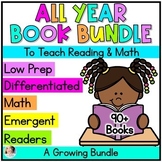Spring Math Activities Kindergarten - Spring Story Problems - Making Teen Number
- Zip
Also included in
- These mini books are perfect to hit almost every math standard for the year! Save time by teaching math and reading at the same time with these math emergent readers. Keep students engaged with monthly themed differentiated decodable books!This Year-Long Bundle Includes:12 different emergent readePrice $39.99Original Price $88.45Save $48.46
Description
These Spring math activities for Kindergarten are designed to help Kindergarten and Pre-K students practice reading and math skills at the same time! These make the perfect April math center where students can work on making teen numbers, Easter measurement, Spring story problems, fine motor skills and more!
These 6 emergent readers are the perfect activity for Spring in your Pre-K or Kindergarten classroom! Plus each book comes with multiple versions for easy differentiation.
These mini-books include themes such as spring, counting eggs, frogs & MORE!
This April Set includes:
6 different emergent readers with and without dots to help students with 1 to 1
- Frogs At The Pond (composing and decomposing teen numbers. (There are 10 frogs on logs and 4 frogs on rocks. How many frogs are at the pond?) includes numbers 11-20
- I Can Count by 10's Egg Delivery (The bunny has 30 eggs to deliver.) counts by 10's to 120
- We Can Recycle addition within 10 (At the park, we found 2 cans and 2 water bottles to recycle. How many things did we find to recycle?) includes numbers 0-9 with answers 2-10
- Carrot Crunch subtraction within 10 (The bunny had 2 carrots. Then he ate 1 carrot. How many carrots are left?) includes numbers 0-10
- Spring Measuring (How tall is the carrot? The carrot is ___ links/inchworms tall.) objects are 1-4 links or inchworms tall.
*with 4 versions (both book options have either links or inchworms)
- Where is the Chick? (Where is the chick? The chick is above the eggs.)
*bonus interactive version where students read the sentence and move the object to match
includes: over, above, below, under, next to, beside, on, between, on top of, in front of, behind, close to, far from, inside, and near
*Books with numbers also include a book without numbers for students to practice counting and writing the number in.
(Each book that is linked is the digital AND printable version of these books. This is a listing for the printable books ONLY. If you are interested in the digital and printable bundle, you can view it HERE.)
Each reader has:
- a black and white PDF version with 2 books to a page (no shuffling pages, just staple and cut!)
Plus:
- A Reference page to see which skills and sight words are addressed in each book
- A Parents Tips page with an editable version included
What teachers are saying about the these books...
⭐⭐⭐⭐⭐ "The dots under the words help so much for those students just learning concepts about print. Thank you for sharing your resources!" -Peggy
⭐⭐⭐⭐ "This is a great way to combine reading and math. My kids love these books!" -KinderStarStyle
**Please note these books are already included in the digital and printable math emergent reader bundles listed in my store. If you have any questions, please email me or ask in the QA to keep from purchasing a duplicate item.






